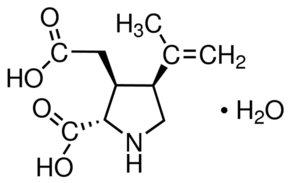All AbMole products are for research use only, cannot be used for human consumption.

Kainic acid monohydrate is an agonist at the kainate class of ionotropic glutamate receptors, which induces seizures and neurodegeneration in vivo and is used to induce experimental epilepsy in rodents and study the mechanisms of excitation-induced neuronal apoptosis.

Phytomedicine. 2024 Jul 16.
Withaferin A protects against epilepsy by promoting LCN2-mediated astrocyte polarization to stopping neuronal ferroptosis
Kainic acid monohydrate purchased from AbMole
| Molecular Weight | 231.25 |
| Formula | C10H15NO4.H2O |
| CAS Number | 58002-62-3 |
| Solubility (25°C) | Water 10 mg/mL (ultrasonic and warming) |
| Storage |
Powder -20°C 3 years ; 4°C 2 years In solvent -80°C 6 months ; -20°C 1 month |
| Related Animal Modeling Products |
|---|
| Sodium Thioglycolate
Sodium thioglycolate acts as reducing agent and is suitable for anaerobic and microaerophilic bacterial growth. Sodium thioglycolate is a commonly used reagent for bacteriological research to maintain reducing conditions in media. Thioglycolate can also protect enzymes against inactivation by maintaining protein thiol groups in the reduced state. Thioglycolate medium is frequently used in inflammation research to elicit a neutrophil and macrophage response in vivo. |
| Vancomycin-d10 2TFA salt
Vancomycin-d10 2TFA salt |
| Acetic acid-d4
Acetic acid-d4 |
| Myosin H Chain Fragment, mouse acetate
Myosin H Chain Fragment, mouse acetate salt is a fragment of the α-Myosin heavy chain peptide. Myosin H Chain Fragment can be used to induce experimental autoimmune myocarditis (EAM) mouse model. |
| Myosin H Chain Fragment, mouse
Myosin H Chain Fragment, mouse is a fragment of the α-Myosin heavy chain peptide. Myosin H Chain Fragment can be used to induce experimental autoimmune myocarditis (EAM) mouse model. |
All AbMole products are for research use only, cannot be used for human consumption or veterinary use. We do not provide products or services to individuals. Please comply with the intended use and do not use AbMole products for any other purpose.


Products are for research use only. Not for human use. We do not sell to patients.
© Copyright 2010-2024 AbMole BioScience. All Rights Reserved.
